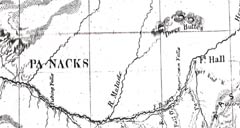|
| |
Sign language for Shoshone
"Hold the right hand, back to right, in front of right shoulder at
about height of waist and near it, first and second fingers extended, touching,
and pointing to front, others and thumb closed; move the hand several inches
to front, and, by wrist action, give a wavy, sinuous motion to extended
fingers. Frequently only the index finger is extended. I have also seen
signs made for Bad Lodge or Brush Lodge to denote these people" (Clark: 1885).
|
| |
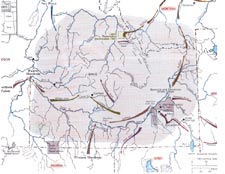
Nineteenth
century territory of Northern Shoshone and Bannock.
Adapted from Handbook of North American Indians, Volume 11, Murphy and Murphy,
1986. |
|
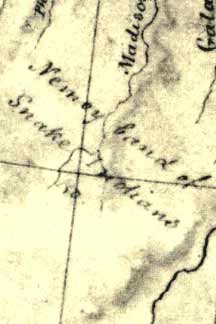
Portion
of 1806 map by Lewis and Clark
(Moulton Atlas: 1983).
Explore Captain Wm. Clark's notations for Shoshone/Snake band names on this
portion of the 1806 map. Locate the Three Forks of the Missouri River for orientation. |
| |
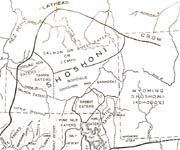
Portion
of map showing distribution of Shoshonean groups in the Great Basin.
(Steward: 1937)
|
Robert "Red" Perry
Where the Bannocks come from.
|
|
|
|
|
|
|
| Tukudikas
join with Agaidikas |
|
|
Lemhi Pass > Culture > Who's Who
|
Shoshone people call themselves ne'we, or in the plural ne'we-ni,
"the people".
|
| |
| When Europeans first wandered into their lands, the tribes
who spoke the Shoshonean language occupied a large part of the western United
States, centered in the Great Basin but extending across the Rocky Mountains
into Wyoming and Montana for buffalo hunts.
|
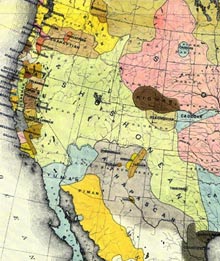
Portion of J.W. Powell's 1890 Map
of Linguistic Stocks of American Indians, From Bureau of Ethnology.
Courtesy of The University of Montana Mansfield Library. |
|
| |
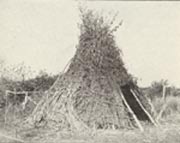
Shoshone wicciup from Wilson
Drigg's The White Indian Boy.
|
According to John Rees, former agent on the Lemhi Reservation
in the late 19th century, the name Shoshone comes from the Indian words
"shawnt" which means "abundance", and "shaw-nip",
meaning "grass", or "abundance of grass". This name
was attached to them because they camped in places where there was sufficient
grass for their horses and because they used grass woven into mats to construct
their "houses" or "wickiups". As these
Indians were grass weavers they were known among the Indians as the "grass
house people". |
|
| |
| Shoshone people lived in extended family bands, gleaning a living from
a mixed diet in a relatively harsh country. The earliest mention of northern
Shoshone groups by fur traders in the region generally refers to the people
as Snakes or Shoshones. |
| |
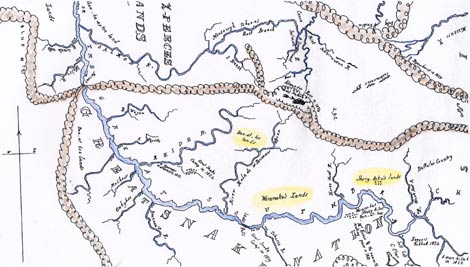
Click on the map, then you can click
on the yellow areas for detailed descriptions of Shoshone bands from Alexander
Ross in 1820s.
Adapted from 1821 Alexander Ross Map of Columbia.
Courtesy of Ellensburg Public Library
Various Names from Early Observers
One of the early fur traders with the Hudson's Bay Company,
Donald McKenzie, reported "The Great Snake nation may be divided into
three divisions, the Shirry-dikas, or dog-eaters; the War-are-ree-kas,
or fish eaters; and the Ban-at-tees, or robbers, but as a nation
they all go by the name Sho-shone or Snakes. The word Shoshone means in
their language 'inland'" (Ross: 1956).
The Shoshones were the most northerly tribe of this huge
language family. Their habitat was along the watershed of the Snake River
in Idaho, although they roamed over much of the adjacent country.
Through the decades of the late 18th and early 19th centuries,
alliances between bands changed as a result of warfare with surrounding
tribes.
"Evidence points to the fact that enemies, possibly
the Blackfeet, drove a wedge in their ranks. Those to the north fled to
the mountains and westward into Idaho, where they came, perhaps for a second
time, under the influence of their Plateau neighbors. Although the term
did not originate until a half-century later, they have gone down in history
as Lemhi Indians" (Trenholm and Carley, 1964:viii).
All of the changes in band composition made it difficult
for observers to distinguish who was who. Some observers even failed to
note the language differences between Shoshone and Bannock. Virginia Trenholm
and Maurine Carley, in their book The Shoshonis, Sentinels of the Rockies,
discuss three groups of Shoshones on the northeastern frontier of the Shoshone
territory, in addition to the Sheep Eaters of the Yellowstone Park area.
Only one of these bands can be directly correlated with Shoshonean groups
noted by Alexander Ross and other early fur traders.
Agaidukas = Salmon Eaters "Lemhi Shoshone" (Lemhi and Salmon
River area). (The Agaidukas correspond to Ross' War-are-ree;
Pohogues = People of the Sage (Ft. Hall area people) can be considered
to be "mixed bands of Shoshones and Bannocks;"
Kogohues= Green River Shoshones, often joined Lemhis and mixed bands
for excursions;
Tukadukas = Sheep Eaters. Lived in the mountains, without horses.
Observers, through the years have tried to distinguish one
Shoshone band from another on the basis of their focal food but, as Brigham
Madsen has pointed out, "one day a Shoshoni group might happen to be
rock chuck eaters; another day the same Indians might be camas eaters, or
deer eaters, or fish eaters" (Madsen: 1990:25). Locational references,
including Lemhi Shoshone and Fort Hall Shoshone, have proved to be longer
lasting.
Read
Capt. Haller's 1854 description of Shoshone bands.
|
| |
| Shoshone and Bannocks of Fort Hall |
| |
| Pohogues, "People of the Sage" are the Shoshone and
Bannock at Fort Hall, Idaho. They belong to two different linguistic groups
(although both belong to the Uto-aztecan linguistic families). On one hand
there are the so-called "pohague," "sagebrush people,"
belonging to the Shoshone linguistic tribe, and on the other hand there
are the Bannock, whose language is more closely related to the Northern
Paiutes or Paviotsos. Both groups, since the beginning of 1800's, have liked
to operate together and the connection between them has been strengthened
by several marriages.
"The Bannocks have - probably rather late - turned away from their
linguistic friends in Oregon. They have been spread over great parts of
Idaho and bordering parts of Montana and Wyoming; and a great number of
Shoshones on the Wind River reservation have Bannock blood in their veins,
several families having typical Bannock names. The Bannocks appeared in
several groups: some were in scattered single families or small bands, with
or without horses, in the northern and western part of the area which they
inhabited; mounted Bannock were found near Fort Hall and along the Snake
River, who, in later times, could collect into larger bands. The Shoshone
in Wyoming tell about the Bannocks that visited Salmon River, calling them
Northern Bannocks, while those who lived on the lower sections of Snake
River are called Southern Bannocks.
"The Bannocks didn't distinguish themselves much from their Shoshone
neighbors as far as mode of living and habits are concerned. Those Bannocks
who stayed around Fort Hall (which happened to be the winter quarter even
before the time of the reservation) congregated often, as we just mentioned,
into bands which fought with the military organization reminiscent of the
Washakie Shoshones, although it was not of the same firm type. And the chieftains
like Tagi or Buffalohorn made expeditions to the buffalo countries
east of the mountains, often along the famous Bannock trail in Yellowstone
Park" (Hultkrantz 1974:13-22).
|
| |
| Who are the Lemhi Shoshone? |
| |
| John Rees, former Indian Agent on the Lemhi Reservation, helps to give
some perspective about the coalescing of these different groups through
the 19th century:
"At the time Lewis and Clark visited the Lemhi country in 1805 there
were about 500 Shoshonis then occupying the land under Chief Cameahwait.
In 1855 the Mormons found the country still inhabited by Shoshonis under
Chief Snagg together with some roving Bannacks, but the gold miners of 1866
found a mixed tribe which was composed of Shoshonis, Tukuarikis (Sheepeater)
and Bannacks who had gathered into one congregation and had selected Tendoy
as their chief, and as they did not constitute a separate tribe, they became
known as "Tendoy"s Band." After becoming settled on the Lemhi
Reservation in Lemhi Valley in 1875 where they intermarried, they soon coalesced
in to a tribe now called the "Lemhis", and so extensively did
they intermarry that in 1900, excepting some old people, there were no full
blooded Shoshonis, Tukuarikas or Bannacks among them, so they were
enumerated in the census, as a single tribe. In 1905 they gave up the Lemhi
reserve and were later removed to Ft. Hall numbering at the time 474 Souls"
(Rees: 1992).
Salmon Eaters, Agaidika
The following excerpts are from Ake Hultkrantz's research report produced
and submitted to the Indian Claims Commission in the 1950's.
Agaidika (salmon eaters) along the Lemhi River, Idaho.
"Agaidikas called themselves "pia agaidika,"
"big salmon eaters" - "because we caught big salmon,"
an old man told me. The same name, however, has been given to those salmon
eating Shoshones who lived on the Camas prairie.
"The Agaidikas still remember the time when they had no horses
and lived on wild grass, berries, fruits, pinyon nuts, fish (salmon and
trout) and some big game which existed in the neighborhood: antelopes and
deer and sheep in the mountain. Although fishing played a very important
role and among other things, demanded collective effort, it was not dominating;
but it put its stamp on the daily lives of the Shoshone culture, a culture
which showed many different economic activities" (Hultkrantz: 1974).
| Explorer John C. Fremont observed Salmon Eaters in his journals in 1843.
The following scene was described at "Fishing Falls", today's
Shoshone Falls on the Snake River. |
Portion of 1848 Fremont map of Oregon
and Upper California.
Courtesy of University of Montana Manfield Library. |
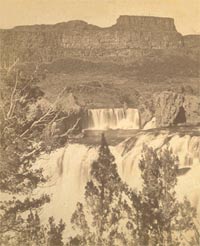
Shoshone
Falls,
image taken as part of the U.S. Corps of Engineers western survey expedition
of 1874.
Courtesy the Corps of Engineers.
| "... encamped at sunset on the river, near several lodges of Snake
Indians.
"Our encampment was about one mile below the Fishing falls,
a series of cataracts with very inclined planes, which are probably so named
because they form a barrier to the ascent of the salmon; and the great fisheries
from which the inhabitants of this barren region almost entirely derive
a subsistence commence at this place.
|
"These appeared to be unusually gay savages, fond of loud laughter;
and, in their apparent good nature and merry character, struck me as being
entirely different from the Indians we had been accustomed to see. From
several who visited our camp in the evening, we purchased, in exchange for
goods, dried salmon. At this season they are not very fat, but we were easily
pleased. The Indians made us comprehend, that when the salmon came up the
river in the spring, they are so abundant that they merely throw in their
spears at random, certain of bringing out fish.
"These poor people are but slightly provided with winter clothing;
there is but little game to furnish skins for the purpose; and of a little
animal which seemed to be the most numerous, it required 20 skins to make
a covering to the knees. But they are still a joyous talkative race, who
grow fat and become poor with the salmon, which at least never fail them-the
dried being used in the absence of the fresh. We are encamped immediately
on the river bank, and with the salmon jumping up out of the water, and
Indians paddling about in boats made of rushes, or laughing around the fires,
the camp to-night has quite a lively appearance" (Fremont: 1845).
Sheep Eaters, Tukadika
"Tukudika (the proper name is "meat-eaters,"
but the word has also the meaning of "eaters of big horn sheep").
These people lived in the high areas around Salmon River, Idaho. They were
also called "toyaino," "mountain dwellers," and
in later times have also been called Agaidika.
"The Tukudikas built up their economy in the same way as
the Agaikikas; they collected herbs, berries, and roots, fished and
hunted. But unlike the Agaidikas they spent comparatively more time
at fishing than in other ways of gathering food; moreover, the Tukudikas
spent more time at hunting than at fishing. Now and then they hunted deer
and those who did so were called "Tihiyadika," "Deer
eaters" - but they killed mainly the mountain sheep" (Hultkrantz: 1974).
In W. A. Allen's The Sheep Eaters (published in 1913), Allen
relates this story told him by a 115 year old Sheep Eater named "The
Woman Under the Ground." According to Allen, she spoke in sign language:
|
"My people lived among the clouds. We were the Sheep Eaters who
have passed away, but on those walls are the paint rocks, where our traditions
are written on their face, chiseled with obsidian arrow heads. Our people
were not warriors. We worshipped the sun, and the sun is bright and so were
our people. Our men were good and our women were like the sun. The Great
Spirit has stamped our impressions on the rocks by His lightenings; there
are many of our people who were outlined on those smooth walls years ago;
then our people painted their figures, or traded them with beautiful colored
stones, and the paleface calls them "painted rocks."
|
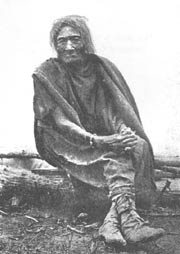
"The Woman Under the Ground",
a 115 yr. old Sheepeater interviewed by W. A. Allen.
(Allen: 1913) |
"Our people never came down into the valleys, but always lived among
the clouds, eating the mountain sheep and the goats, and sometimes the elk
when they came high on the mountains. Our tepees were made of the cedar,
thatched with grey moss and cemented with the gum from the pines, carpeted
with the mountain sheep-skins, soft as down. Our garments were made from
the skins of the gazelle, and ornamented with eagle feathers and ermine
and otter skins.
"We chanted our songs to the sun, and the Great Spirit was pleased.
He gave us much sheep and meat and berries and pure water, and snow to keep
the flies away. The water was never muddy. We had no dogs nor horses. We
did not go far from our homes, but were happy in our mountain adobe" (Allen:
1913).
The Tukuarikas or sheepeaters tribe
"were driven into the hills and mountains by the Blackfoot Indians.
They adopted a new mode of living which consisted of living on bighorn sheep,
dressing in furs and skins, and dwelling in rocks and caves. They did not
have horses nor firearms, and used the dog as a beast of burden, and had
bows and arrows. They were slender and wiry. Their homes were in the most
secluded, highest points in the mountains. They had no modern implements,
used the obsidian knife and hatchet, dressed in animal skins. They were
called the wild men of the mountains. Lewis and Clark called them the Broken
Moccasin Indians. They were removed to the Lemhi Reserve and became amalgamated
with that tribe" (Rees: ISU Manuscripts).
|
| |
| Background: Shoshone Falls, image
taken as part of the U.S. Corps of Engineers western survey expedition of
1874. Courtesy the Corps of Engineers. |
|
|
|
















